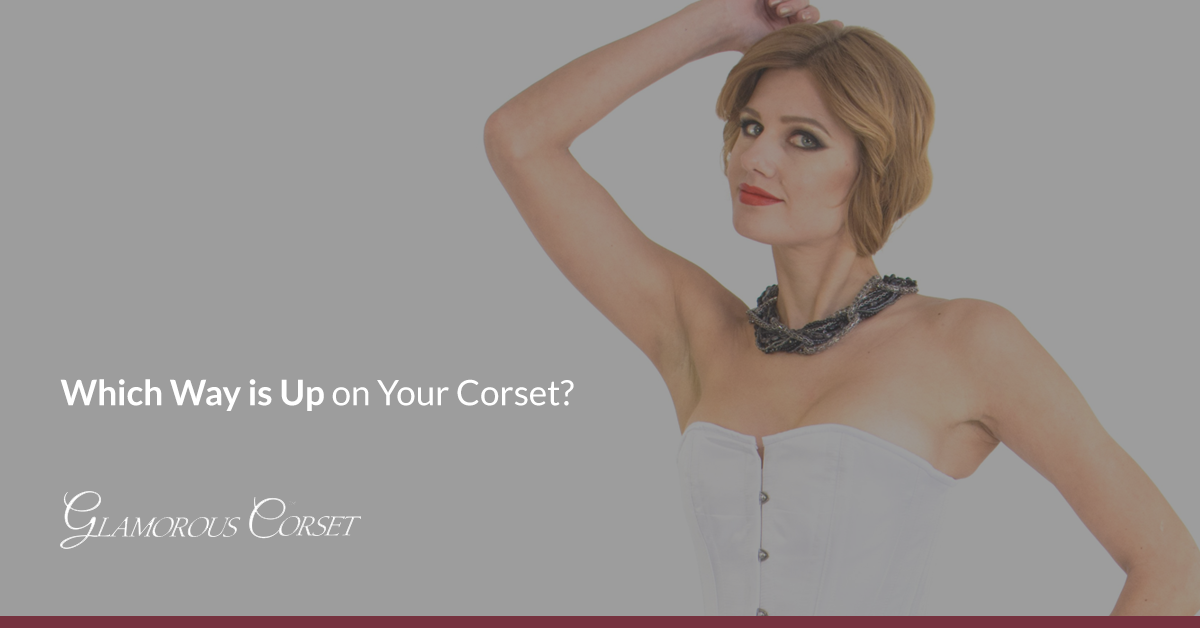Blog
Which Way is Up on Your Corset?
We live in a topsy-turvy world where fashion tropes are constantly turned on their head – just look at trends like wearing shirts backward or inside out, or wearing a shirt as a skirt with arms tied into a bow at the waist. Yes, apparently that’s a thing that happens. Regardless, you don’t necessarily want to get overly experimental with wardrobe staples like undergarments. You’re not likely to turn your knickers into a top, and when you wear a corset, you probably want to put it on right-side up.
While seasoned wearers can take one look at an underbust corset and tell you which side is up, newbies may have a harder time puzzling it out. Don’t worry, you’re not alone on this one. Depending on the size and the spring of your corset, it may look the same at the top and bottom, leaving you scratching your head. The good news is, there are several clues that can help you to figure out which way to orient this garment when putting it on. Here are a few tips to get your corset right-side up.
Label Orientation
One of the quickest ways to tell which side is up on your corset is to look for a maker’s label. If it’s sewn into the top seam, all you have to do is make sure the logo is right-side up. If the label is sewn into a vertical seam or there’s no label, you’ll have to try another method.
Busk Orientation
If you’ve ever grabbed your man’s Oxford for a loose coverup, you’ve probably noticed that the buttons are situated on the opposite side of the shirt. That’s right, men’s shirts have buttons on the right placket (the right side of the body) while women’s shirts have them on the left. Funny story, this is because women were traditionally dressed by lady’s maids, so the buttons were put on the left so maids could use their right hands for easier buttoning. Mystery solved!
What does this have to do with your busks? Well, the best way to tell if your corset is right-side up is see where the loops and studs are. Traditionally, loops are on the right side of the body and studs are on the left. Because corsets are traditionally made for women, this is nearly always the case, although some men turn women’s corsets upside down to accommodate a larger underbust area and smaller hips, in which case the orientation of busks would be the opposite.
Suspender Loops
Many corsets come equipped with suspender loops to hook garter straps (also referred to as suspenders) into. These are obviously going to be situated along the bottom edge of the corset so you can suspend garter straps to hold up your thigh-high stockings. If you find 4-6 loops sewn into one edge of your corset, you’ll know which side of the garment should point south.
Lacing Knot
When it comes to telling up from down on your corset, you might look at lacing in despair – traditionally, bunny ears (loops for tightening lacing) are situated smack in the middle of your rows of grommets. That said, when corsetmakers lace your garment for you, you can reasonably expect these professionals to know which side is the top.
All you have to do is look for the knot where the ends of laces meet. Lacing is almost universally done from top to bottom, which means the knot should be hidden somewhere near the bottom of a laced corset.
Trial and Error
If all else fails and you simply can’t work out the up and down of your garment, try it on both ways, uniformly tighten laces to a snug fit, and see which way feels better. Whether you elect to wear it right-side up or upside down, comfortable fit trumps convention.
Stay up-to-date with weekly blog posts, waist training tips, and the chance to win one of our monthly corset giveaways, like us on Facebook & subscribe to our mailing list today! Want to find the perfect steel boned corset? Shop some of our favorites: underbust corsets, overbust corsets, corset dresses. You can also shop our corsets by material: cotton corsets, denim corsets, leather corsets, mesh corsets, pvc corsets, and satin corsets.

My name is Rachel, I am the owner of Glamorous Corset, a small business founded by me in 2010. Back In 2005, I was in a car accident that left me with a herniated disk. Much to my surprise I learned steel boned corsets were beneficial to several medical injuries including mine. I was always intrigued with corsetry, their history and their beautiful aesthetic. I love sharing knowledge about corsets, educating my wonderful readers and breaking the negative stigma related to corsetry. In combination with my years of research and personal experience I hope my articles are useful and can help anyone who has struggled with some of the same things I have. More about me…


